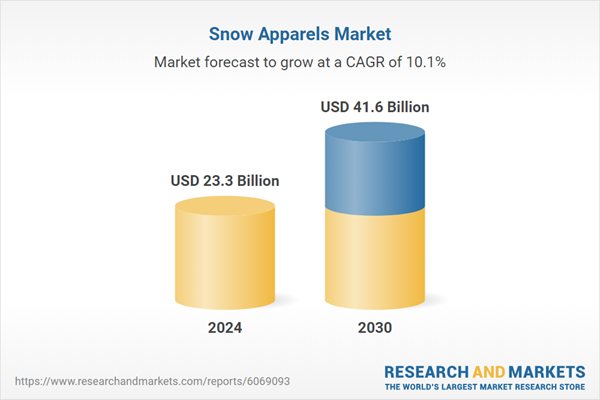Global Snow Apparel Market - Key Trends & Drivers Summarized
Why Is the Snow Apparel Market Expanding? Understanding Its Role in Winter Sports and Outdoor Fashion
The increasing popularity of winter sports, outdoor recreation, and cold-weather travel has driven significant growth in the global snow apparel market. From skiing and snowboarding to alpine trekking and winter hiking, consumers are investing in high-performance clothing designed for warmth, comfort, and durability. Snow apparel includes insulated jackets, base layers, gloves, and technical pants, all engineered to provide protection against extreme weather conditions while maintaining breathability and flexibility. Additionally, advancements in fabric technology have enabled the development of lightweight yet highly insulating materials, making snow apparel more functional for a range of activities. Beyond sports, the rise of winter fashion and streetwear trends has influenced the market, with stylish yet functional snow gear gaining traction among urban consumers. As demand for high-quality, weather-resistant clothing grows, the snow apparel industry continues to expand across both performance and lifestyle segments.How Are Technological Advancements Transforming Snow Apparel? Examining Innovations in Fabric and Sustainability
Innovations in textile engineering and material science have revolutionized snow apparel, enhancing both performance and sustainability. The development of high-tech synthetic insulation materials, such as PrimaLoft and Thinsulate, has improved thermal efficiency without the bulk of traditional down feathers. Additionally, advancements in waterproof and breathable fabrics, including Gore-Tex and eVent technology, have enabled superior moisture management, keeping athletes dry in extreme snow conditions. Sustainable manufacturing practices have also gained importance, with brands prioritizing eco-friendly materials, such as recycled polyester and biodegradable water-repellent coatings. Furthermore, smart textiles and wearable heating technology are emerging trends, integrating temperature regulation features into jackets and gloves. These innovations are driving the evolution of snow apparel, making it more functional, sustainable, and adaptable to diverse weather conditions.What Challenges Are Affecting the Snow Apparel Market? Addressing High Costs and Seasonal Demand Variations
Despite its growth, the snow apparel market faces challenges related to high production costs, seasonality, and environmental impact. The use of advanced fabrics and technical construction processes increases the price of premium snow gear, limiting accessibility for budget-conscious consumers. Additionally, the seasonal nature of winter sports leads to fluctuating demand, requiring brands to balance inventory and manage off-season sales effectively. Environmental concerns regarding synthetic insulation, chemical waterproofing agents, and textile waste also pose challenges, prompting brands to adopt more sustainable practices. To overcome these obstacles, companies are focusing on material innovation, circular economy initiatives, and expanding product versatility for year-round outdoor activities.What's Driving the Growth of the Snow Apparel Market? Identifying Key Consumer Trends and Industry Developments
The growth in the snow apparel market is driven by several factors, including the rising participation in winter sports, increasing investment in outdoor gear, and the expansion of sustainable fashion initiatives. The growing number of ski resorts and adventure tourism activities has fueled demand for high-performance snow apparel, particularly in North America and Europe. Additionally, the rise of athleisure and outdoor lifestyle fashion has led to crossover demand for stylish yet functional snow gear. E-commerce and digital marketing have also contributed to market growth, making premium snow apparel more accessible to global consumers. As brands continue to invest in eco-friendly materials, innovative fabric technologies, and performance-driven designs, the snow apparel industry is expected to see continued expansion, shaping the future of winter sports and cold-weather fashion.Report Scope
The report analyzes the Snow Apparels market, presented in terms of market value (US$). The analysis covers the key segments and geographic regions outlined below:- Segments: Product (Top Wear, Bottom Wear, Accessories, Others); Application (Skiing, Snowboarding, Hiking, Others); Distribution Channel (Sporting Goods, National / Multidoor, Specialty Stores, Online, Others).
- Geographic Regions/Countries: World; United States; Canada; Japan; China; Europe (France; Germany; Italy; United Kingdom; and Rest of Europe); Asia-Pacific; Rest of World.
Some of the 36 companies featured in this Snow Apparels market report include -
- Arc'teryx
- Aztech Mountain
- Black Diamond
- Bogner
- Burton Snowboards
- Canada Goose
- Columbia Sportswear
- Dakine
- Flylow Gear
- Fusalp
- Goldbergh
- Halfdays
- Helly Hansen
- Hestra Gloves
- Icebreaker
- Kari Traa
- Mammoth Outerwear
- Mammut
- Moncler
- Norrøna
- Obermeyer
- Outdoor Research
- Patagonia
- Picture Organic Clothing
- REI Co-op
- Salomon
- Smartwool
- Spyder
- Stio
- The North Face
Key Insights:
- Market Growth: Understand the significant growth trajectory of the Top Wear segment, which is expected to reach US$21.9 Billion by 2030 with a CAGR of a 9.4%. The Bottom Wear segment is also set to grow at 9.2% CAGR over the analysis period.
- Regional Analysis: Gain insights into the U.S. market, valued at $6.1 Billion in 2024, and China, forecasted to grow at an impressive 9.5% CAGR to reach $6.5 Billion by 2030. Discover growth trends in other key regions, including Japan, Canada, Germany, and the Asia-Pacific.
Why You Should Buy This Report:
- Detailed Market Analysis: Access a thorough analysis of the Global Snow Apparels Market, covering all major geographic regions and market segments.
- Competitive Insights: Get an overview of the competitive landscape, including the market presence of major players across different geographies.
- Future Trends and Drivers: Understand the key trends and drivers shaping the future of the Global Snow Apparels Market.
- Actionable Insights: Benefit from actionable insights that can help you identify new revenue opportunities and make strategic business decisions.
Key Questions Answered:
- How is the Global Snow Apparels Market expected to evolve by 2030?
- What are the main drivers and restraints affecting the market?
- Which market segments will grow the most over the forecast period?
- How will market shares for different regions and segments change by 2030?
- Who are the leading players in the market, and what are their prospects?
Report Features:
- Comprehensive Market Data: Independent analysis of annual sales and market forecasts in US$ Million from 2024 to 2030.
- In-Depth Regional Analysis: Detailed insights into key markets, including the U.S., China, Japan, Canada, Europe, Asia-Pacific, Latin America, Middle East, and Africa.
- Company Profiles: Coverage of players such as Able C&C Co. Ltd. (Missha), Amorepacific Corporation, Annalia Beauty Pvt. Ltd., Beauty of Joseon, Benton Inc. and more.
- Complimentary Updates: Receive free report updates for one year to keep you informed of the latest market developments.
Select Competitors (Total 36 Featured):
- Arc'teryx
- Aztech Mountain
- Black Diamond
- Bogner
- Burton Snowboards
- Canada Goose
- Columbia Sportswear
- Dakine
- Flylow Gear
- Fusalp
- Goldbergh
- Halfdays
- Helly Hansen
- Hestra Gloves
- Icebreaker
- Kari Traa
- Mammoth Outerwear
- Mammut
- Moncler
- Norrøna
- Obermeyer
- Outdoor Research
- Patagonia
- Picture Organic Clothing
- REI Co-op
- Salomon
- Smartwool
- Spyder
- Stio
- The North Face
This edition integrates the latest global trade and economic shifts into comprehensive market analysis. Key updates include:
- Tariff and Trade Impact: Insights into global tariff negotiations across 180+ countries, with analysis of supply chain turbulence, sourcing disruptions, and geographic realignment. Special focus on 2025 as a pivotal year for trade tensions, including updated perspectives on the Trump-era tariffs.
- Adjusted Forecasts and Analytics: Revised global and regional market forecasts through 2030, incorporating tariff effects, economic uncertainty, and structural changes in globalization. Includes historical analysis from 2015 to 2023.
- Strategic Market Dynamics: Evaluation of revised market prospects, regional outlooks, and key economic indicators such as population and urbanization trends.
- Innovation & Technology Trends: Latest developments in product and process innovation, emerging technologies, and key industry drivers shaping the competitive landscape.
- Competitive Intelligence: Updated global market share estimates for 2025, competitive positioning of major players (Strong/Active/Niche/Trivial), and refined focus on leading global brands and core players.
- Expert Insight & Commentary: Strategic analysis from economists, trade experts, and domain specialists to contextualize market shifts and identify emerging opportunities.
Table of Contents
Companies Mentioned (Partial List)
A selection of companies mentioned in this report includes, but is not limited to:
- Arc'teryx
- Aztech Mountain
- Black Diamond
- Bogner
- Burton Snowboards
- Canada Goose
- Columbia Sportswear
- Dakine
- Flylow Gear
- Fusalp
- Goldbergh
- Halfdays
- Helly Hansen
- Hestra Gloves
- Icebreaker
- Kari Traa
- Mammoth Outerwear
- Mammut
- Moncler
- Norrøna
- Obermeyer
- Outdoor Research
- Patagonia
- Picture Organic Clothing
- REI Co-op
- Salomon
- Smartwool
- Spyder
- Stio
- The North Face
Table Information
| Report Attribute | Details |
|---|---|
| No. of Pages | 231 |
| Published | December 2025 |
| Forecast Period | 2024 - 2030 |
| Estimated Market Value ( USD | $ 23.3 Billion |
| Forecasted Market Value ( USD | $ 41.6 Billion |
| Compound Annual Growth Rate | 10.1% |
| Regions Covered | Global |









